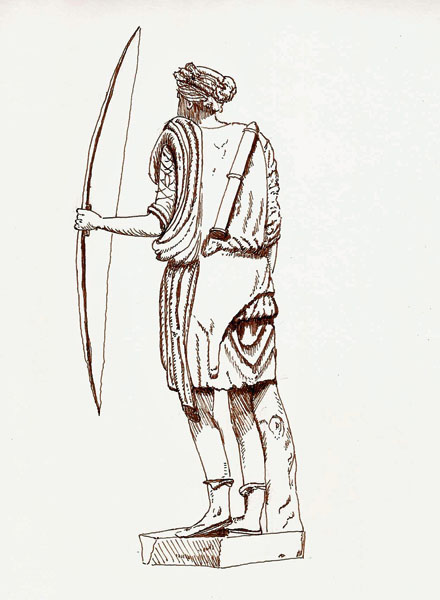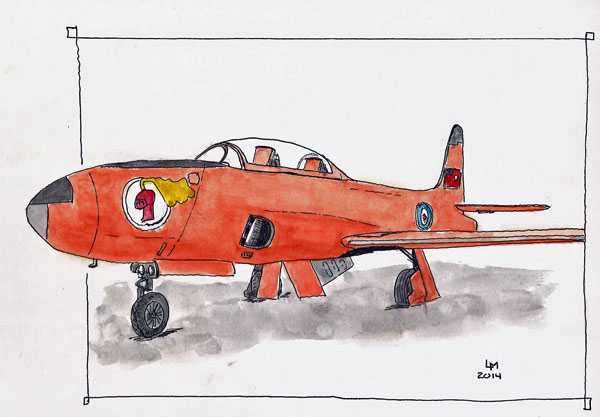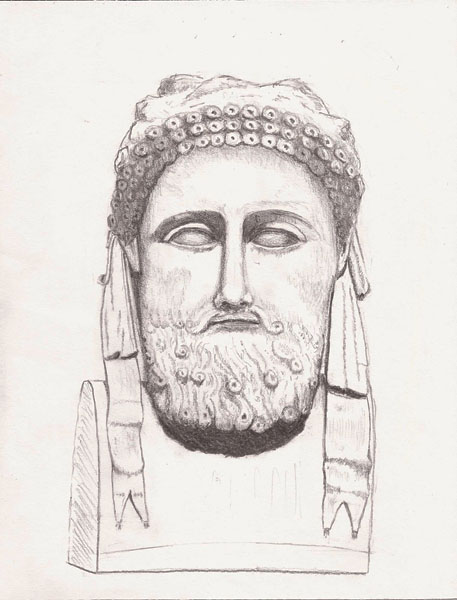I was at the museum yesterday and drew a Roman pitcher. Wednesday mornings are when Liz Steel releases a new lesson of her Foundations Now drawing course. If you’re not already taking it, sign up. We an amazing instructor.
What do those two things have in common? Today’s lesson was about measuring and sketch “setup” to use her terminology. I call it scaffolding but any way you talk about it, the goal is to look at your subject/scene and determine the relative sizes and locations of the objects, making some lines to indicate those relationships. People seem reluctant to think about doing anything before they start drawing the “things” in their drawing but a few minutes spent before you draw actual “stuff” can improve both your accuracy and speed, the later more than compensating for the short time spent in analysis.
Once I got comfortable on my stool I just looked at the subject, trying to get a sense of shapes and sizes. What follows is typically done using a 2H pencils producing lines so faint they won’t scan properly. So, I took some tracing paper and drew them with a red pencil so you can see them. Often I don’t even worry about erasing these lines as most just disappear. Here’s what I did to draw this pitcher and why:
1) I realized that the bulk of the pitcher could fit inside a square. Since I was working in a 10×7 sketchbook, I drew a couple vertical lines about 4″ apart to set the boundary of my drawing on the 7″ dimension of the paper. I completed a square with appropriate horizontal lines. Not only did this determine size but it determined location of the vase on the paper and ensured that I would have enough room and white space to make me happy.
2) I drew a vertical line at the halfway point of the square. Centerlines for objects are generally helpful but in this case it was doubly so because the main pitcher was symmetrical and thus, having a centerline becomes a big help in the symmetrical curvatures of the pitcher sides.
3) I used dimension A to measure how high the pitcher mouth protruded above the main pitcher body and found it to be equal to A. A quick line to identify that limit was all that was necessary, though I could have easily determined the width of the top of the pitcher at this time. I just didn’t think of it.
4) At this point I’d taken a couple measurements using the ‘hold the pen up’ approach and drawn five lines. I’d spent enough time looking at the pitcher to know there were three dips in the top edge of the mouth, that the handle attached between the back two and that the handle was turned a bit towards me and the pitcher spout turned slightly away from me. I’m sure I also noticed other, more subtle things but these were the pertinent things. It’s important to note that this is important information for drawing this pitcher and it’s best to know about it BEFORE you start drawing it rather than after you make an error because you didn’t.
5) At this point I switched to pen, but there was still more analysis work to be done along the way. I felt the first thing I needed to do was locate the handle as it crossed in front of the top of the main pitcher body as I needed to know where that line would be hidden. I thought about picking up the pencil again as it would have been easier to drop a couple angled lines to indicate the hand. But I persevered and looked at 1) what was the distance between the left-most part of the hand from an imaginary vertical running upward from the body square. At the same time I looked at the angle of an imaginary line that would run from the top of the pitcher body and that left-most part of the handle. I put a dot there and another dot across from it to indicate the handle width at that point. I did a similar analysis to determine how high the handle went above the ‘top’ of the pitcher mouth. I don’t remember doing it but I also decided where the handle attached to the side of the pitcher body. Then I drew the outer edges of the handle.
6) I was off to the races at that point. I decided how wide the ‘cylinder’ that protruded to become the mouth was and put marks on either side of the centerline to indicate where it would intersect the pitcher body. Then I drew the entire outline of the pitcher body, stopping briefly to do a similar determination about the base widths.
7) When I draw something more complex, like the convolutions of the mouth top edge, I do a lot of dynamic comparisons. If I were really concerned with absolute accuracy I’d draw pencil lines to indicate the shapes but sometimes I just use my experience to compare a couple angles or locations to determine start/stop points for the various curves. If you’re less experienced it might be a good idea to draw a box around this portion of the pitcher and then remove everything that doesn’t look like a pitcher mouth from that ‘block of clay.’ This is often very powerful as this forces you to look at it as the three dimensional volume that it is.
8) The painted details were pretty straight forward so I just freehanded those directly. This was made easier because my basic drawing was accurate so I could rely upon it to locate the details.
Too often I see people talking about going “direct to ink” as some sort of badge of honor. My goal may be more accuracy than some others but even if you like to draw with a loose style, just a few simple lines can give you the confidence that you’re laying down your loose lines in the right places. You’ll also never be caught saying “I ran out of room for his feet.”









